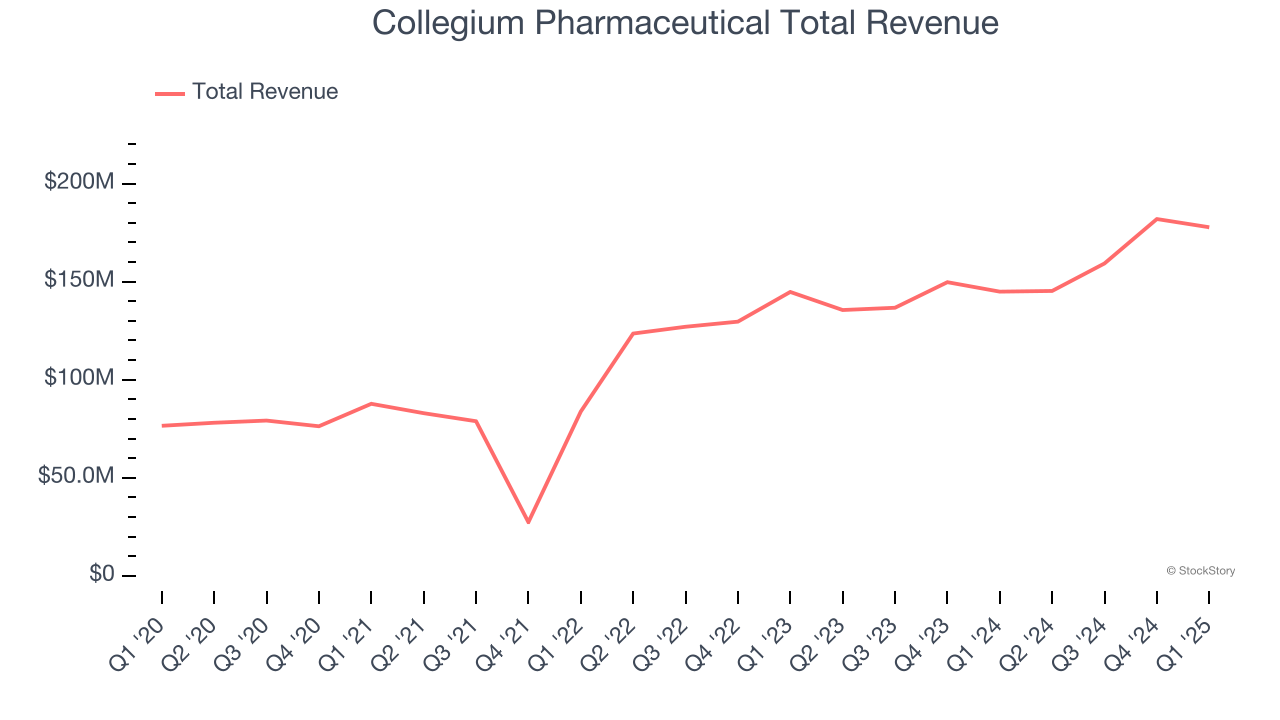
As the Q1 earnings season wraps, let’s dig into this quarter’s best and worst performers in the branded pharmaceuticals industry, including Collegium Pharmaceutical (NASDAQ:COLL) and its peers.
The branded pharmaceutical industry relies on a high-cost, high-reward business model, driven by substantial investments in research and development to create innovative, patent-protected drugs. Successful products can generate significant revenue streams over their patent life, and the larger a roster of drugs, the stronger a moat a company enjoys. However, the business model is inherently risky, with high failure rates during clinical trials, lengthy regulatory approval processes, and intense competition from generic and biosimilar manufacturers once patents expire. These challenges, combined with scrutiny over drug pricing, create a complex operating environment. Looking ahead, the industry is positioned for tailwinds from advancements in precision medicine, increasing adoption of AI to enhance drug development efficiency, and growing global demand for treatments addressing chronic and rare diseases. However, headwinds include heightened regulatory scrutiny, pricing pressures from governments and insurers, and the looming patent cliffs for key blockbuster drugs. Patent cliffs bring about competition from generics, forcing branded pharmaceutical companies back to the drawing board to find the next big thing.
The 10 branded pharmaceuticals stocks we track reported a satisfactory Q1. As a group, revenues were in line with analysts’ consensus estimates.
While some branded pharmaceuticals stocks have fared somewhat better than others, they have collectively declined. On average, share prices are down 3.2% since the latest earnings results.
Collegium Pharmaceutical (NASDAQ:COLL)
Pioneering abuse-deterrent technology in a field plagued by addiction concerns, Collegium Pharmaceutical (NASDAQ:COLL) develops and markets specialty medications for treating moderate to severe pain, including abuse-deterrent opioid formulations.
Collegium Pharmaceutical reported revenues of $177.8 million, up 22.7% year on year. This print exceeded analysts’ expectations by 2.3%. Overall, it was a satisfactory quarter for the company with a decent beat of analysts’ EPS estimates.
“Collegium is off to a strong start in 2025. We have made significant progress towards our key strategic priorities including growing Jornay PM, maximizing our pain portfolio, and strategically deploying capital to further enhance shareholder value,” said Vikram Karnani, President and Chief Executive Officer.

Interestingly, the stock is up 8.1% since reporting and currently trades at $29.50.
Is now the time to buy Collegium Pharmaceutical? Access our full analysis of the earnings results here, it’s free.
Best Q1: Bristol-Myers Squibb (NYSE:BMY)
With roots dating back to 1887 and a transformative merger in 1989 that gave the company its current name, Bristol-Myers Squibb (NYSE:BMY) discovers, develops, and markets prescription medications for serious diseases including cancer, blood disorders, immunological conditions, and cardiovascular diseases.
Bristol-Myers Squibb reported revenues of $11.2 billion, down 5.6% year on year, outperforming analysts’ expectations by 3.9%. The business had a very strong quarter with a solid beat of analysts’ EPS estimates and full-year revenue guidance slightly topping analysts’ expectations.

Bristol-Myers Squibb achieved the biggest analyst estimates beat among its peers. Although it had a fine quarter compared to its peers, the market seems unhappy with the results as the stock is down 1.4% since reporting. It currently trades at $47.85.
Is now the time to buy Bristol-Myers Squibb? Access our full analysis of the earnings results here, it’s free.
Weakest Q1: Eli Lilly (NYSE:LLY)
Founded in 1876 by a Civil War veteran and pharmacist who was frustrated with the poor quality of medicines available at the time, Eli Lilly (NYSE:LLY) discovers, develops, and manufactures pharmaceutical products for conditions including diabetes, obesity, cancer, immunological disorders, and neurological diseases.
Eli Lilly reported revenues of $12.73 billion, up 45.2% year on year, exceeding analysts’ expectations by 0.9%. Still, it was a slower quarter as it posted a significant miss of analysts’ full-year EPS guidance estimates.
As expected, the stock is down 15.1% since the results and currently trades at $761.02.
Read our full analysis of Eli Lilly’s results here.
Supernus Pharmaceuticals (NASDAQ:SUPN)
With a diverse portfolio of eight FDA-approved medications targeting neurological conditions, Supernus Pharmaceuticals (NASDAQ:SUPN) develops and markets treatments for central nervous system disorders including epilepsy, ADHD, Parkinson's disease, and migraine.
Supernus Pharmaceuticals reported revenues of $149.8 million, up 4.3% year on year. This print surpassed analysts’ expectations by 1.3%. More broadly, it was a slower quarter as it recorded full-year operating income guidance missing analysts’ expectations.
Supernus Pharmaceuticals had the weakest full-year guidance update among its peers. The stock is up 3.5% since reporting and currently trades at $33.57.
Read our full, actionable report on Supernus Pharmaceuticals here, it’s free.
Corcept (NASDAQ:CORT)
Focusing on the powerful stress hormone that affects everything from metabolism to immune function, Corcept Therapeutics (NASDAQ:CORT) develops and markets medications that modulate cortisol to treat endocrine disorders, cancer, and neurological diseases.
Corcept reported revenues of $157.2 million, up 7.1% year on year. This result missed analysts’ expectations by 11.6%. In spite of that, it was a satisfactory quarter as it produced a solid beat of analysts’ EPS estimates.
Corcept scored the highest full-year guidance raise but had the weakest performance against analyst estimates among its peers. The stock is down 6.9% since reporting and currently trades at $68.99.
Read our full, actionable report on Corcept here, it’s free.
Market Update
Thanks to the Fed’s series of rate hikes in 2022 and 2023, inflation has cooled significantly from its post-pandemic highs, drawing closer to the 2% goal. This disinflation has occurred without severely impacting economic growth, suggesting the success of a soft landing. The stock market thrived in 2024, spurred by recent rate cuts (0.5% in September and 0.25% in November), and a notable surge followed Donald Trump’s presidential election win in November, propelling indices to historic highs. Nonetheless, the outlook for 2025 remains clouded by potential trade policy changes and corporate tax discussions, which could impact business confidence and growth. The path forward holds both optimism and caution as new policies take shape.
Want to invest in winners with rock-solid fundamentals? Check out our Strong Momentum Stocks and add them to your watchlist. These companies are poised for growth regardless of the political or macroeconomic climate.
